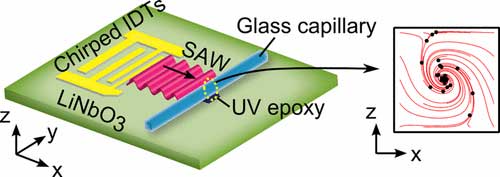| Posted: Jan 25, 2017 |
Expanding point-of-care disease diagnostics with ultrasound
(Nanowerk News) Fast, accurate and inexpensive medical tests in a doctor's office are only possible for some conditions. To create new in-office diagnostics for additional diseases, researchers report in the journal ACS Nano ("Enriching Nanoparticles via Acoustofluidics") a new technique that uses ultrasound to concentrate fluorescently labeled disease biomarkers otherwise impossible to detect with current equipment in an office setting. The markers' signal could someday be analyzed via a smartphone app.
|
 |
| An acoustofluidic chip generates single vortex acoustic streaming inside a glass capillary through using low-power acoustic waves.
|
|
Ultrasound is a safe, noninvasive, inexpensive and portable technique best known for monitoring pregnancies. But these high-frequency acoustic waves can also be used to gently handle blood components, cells and protein crystals at the microscopic level.
|
|
With an eye toward point-of-care diagnostic applications, Tony Huang, Zhangming Mao and colleagues wanted to harness these sound waves to help detect even smaller particles and biomarkers for diseases such as cancer that often require special laboratory equipment to detect.
|
|
The researchers developed an acoustofluidic chip that, though vibrations, can form a streaming vortex inside a tiny glass capillary tube using a minimal amount of energy. Testing showed that the vortex could force nanoparticles ranging in diameter from 80 to 500 nanometers to swirl into the center of the capillary.
|
|
The nanoparticles captured biomarkers labeled with a fluorescent tag, concentrating them in the capillary to boost their signal. This increased brightness could make the signal readable with a smartphone camera.
|

